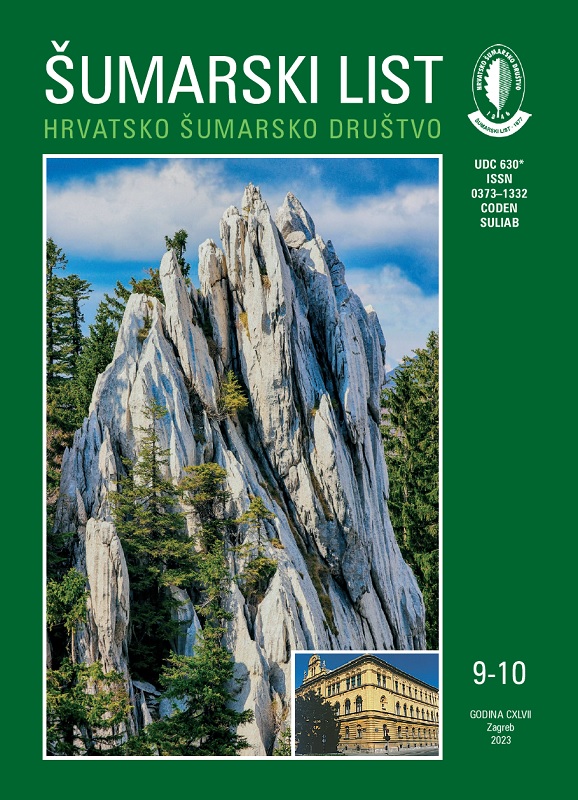
broj: 9-10/2023
pdf (11,98 MB) |
|
||||||||||||||
| RIJEČ UREDNIŠTVA | ||
| Uredništvo | ||
| Should there be concern over the future of human resources in forestry? pdf HR EN | 415 | |
| IZVORNI ZNANSTVENI ČLANCI | ||
| Marija Pandža, Milenko Milović, Vesna Krpina, Damira Tafra | UDK 630*182 (001) https://doi.org/10.31298/sl.147.9-10.1 | |
| The flora of the island of Rivanj and the vegetation of the macchia and forest of Rivanj and the Sestrice islets pdf HR EN | 417 | |
| Summary According to literature data and field research conducted in 2019 and 2020, there are 346 vascular native and non-native taxa with the ability to survive outside crops (309 species, 36 subspecies and varieties) on the island of Rivanj (3,615 km2). Including 84 taxa in cultivation, we state that the total flora of Rivanj numbers 430 taxa. Those in cultivation are not included in the flora analysis. During earlier research, 45 taxa were recorded, while 385 taxa are listed for the first time in this work. In addition to the flora inventory, a taxonomic, ecological and phytogeographical analysis was performed. The results are presented in Tables 1–4 and Figure 2. The composition of the flora is dominated by angiosperms, in which dicotyledons (73.99%) are significantly more common than monocotyledons (23.99%). The flora also includes two ferns and 5 gymnosperms. By the number of taxa, the most represented families are Poaceae (13.01%), Asteraceae s.l. (11.85%) and Fabaceae (8.96%). The spectrum of life forms is dominated by therophytes (43.93%) and hemicryptophytes (24.28%), while plants of the Mediterranean floral element (42.77%) dominate in the phytogeographical analysis, which indicates the climatic conditions and geographical position of the island of Rivanj. Four endemics and four endangered taxa (Lathyrus ochrus – critically endangered, Carex extensa – endangered and two vulnerable taxa: Orchis tridentata and Parapholis incurva) were recorded in the flora, as well as five orchid. Eleven invasive taxa were recorded in the weed and ruderal vegetation of the settlement (3.18% of the total flora of the island). The investigation of the macchia and forest vegetation of the island of Rivanj and the islets of Sestrice was conducted in 2019 and 2020. The relevés were produced and analyzed according to the Braun-Blanquet method. Thirty relevés presenting the vegetation of the Quercetea ilicis and Pinetea halepensis classes were statistically analyzed and their dendrogram created. The results are shown in Tables 5–7 in accordance with the classic presentation regarding phytosociological relevés. Through the syntaxonomic analysis the Erico arboreae-Arbutetum unedonis Allier et Lacoste 1980 ex Foggi in Foggi et Grigioni 1999, Myrto communis-Pistacietum lentisci (Molinier 1954) Rivas-Martínez 1975, Pistacio lentisci-Juniperetum turbinatae Trinajstić 1987 ex Asensi, Díez-Garretas & Quézel 2007 and Myrto communis-Quercetum ilicis (Horvatić 1963) Trinajstić (1976) 1985 associations from the Quercetea ilicis class and the Pistacio lentisci-Pinetum halepensis De Marco, Veri & Caneva 1984 association. The autochthonous macchia and forest vegetation is mostly endangered by planted community of Aleppo pine on the islet of Mala Sestrica and on smaller areas on the island of Rivanj. North-west of the settlements on the Rivanj island a thick and impassable macchia grows. It is necessary to clear out the firefighting access paths and ban all activities that might cause fire. Key words: phytosociology; the island of Rivanj and the islets of Sestrice; Northern Dalmatia; the Zadar archipelago; vascular flora | ||
| Dževada Sokolović, Zerina Dupovac, Amina Karišik, Jelena Knežević, Velid Halilović, Jusuf Musić | UDK 630* 383 (001) https://doi.org/10.31298/sl.147.9-10.2 | |
| Damage on forest roads as a result of improper construction pdf HR EN | 433 | |
| Vojislav Dukić, Srđan Bilić, Danijela Petrović, Goran Jović | UDK 630*810 (001) https://doi.org/10.31298/sl.147.9-10.3 | |
| Applicability of different regression models for estimation of merchantable wood volume of sessile oak (Quercus petraea (Matt.) Liebl.) in Bosnia and Herzegovina pdf HR EN | 445 | |
| Milan Drekić, Branislav Kovačević, Leopold Poljaković-Pajnik, Andrej Pilipović, Marina Milović, Vid Rađević | UDK 630*453 (001) https://doi.org/10.31298/sl.147.9-10.4 | |
| Impact of oak lace bug Corythucha arcuata on the height of pedunculate oak plants depending on the way of regeneration pdf HR EN | 457 | |
| PREGLEDNI ČLANCI | ||
| Maja Cvek, Doris Šegota, Kaća Piletić, Gabrijela Begić, Maša Knežević, Dijana Tomić Linšak, Marina Šantić | UDK 630*145.7 https://doi.org/10.31298/sl.147.9-10.5 | |
| Mosquitoes in Croatia, transmitting diseases, ways of prevention and control pdf HR EN | 465 | |
| Stanimir Živanović | UDK 630* 431 https://doi.org/10.31298/sl.147.9-10.6 | |
| Determining the fire season by analyzing climatic conditions in northeastern Serbia pdf HR EN | 477 | |


